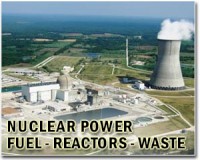 |
Bonn, Germany (SPX) Nov 22, 2010 With the decision to extend the service life of German nuclear power stations and the demonstrations against Castor waste transport, the issue of a definitive solution for storage of nuclear waste is a hot topic once again. For instance, the suitability of the salt deposits in Gorleben, Lower Saxony, is being investigated once again, and other potential storage locations in Germany are being looked into. But is there no alternative to storing nuclear waste for thousands of years underground? Although there is not yet a permanent storage location anywhere in the world, the most popular option is to store the waste hundreds of metres underground, in stable rock that is impervious to water. Now that nuclear waste from the early days of civil nuclear power has been able to cool off for a few decades and current storage facilities are filling up, the search for a permanent storage solution is ever more urgent. But, in principle, there are techniques for reducing the volume of nuclear waste and transforming radioactive substances with especially long half-lives into isotopes that decay more quickly.
Transmutation - the solution to the nuclear waste problem? With an investment of one billion Euro, a pilot facility will be commissioned in 2019 at the Belgian nuclear research centre SCK.CEN as part of the Myrrha project (Multi-purpose Hybrid Research Reactor for High-Tech Applications). After testing for several years, the facility will come into operation in 2024 to demonstrate the feasibility of large-scale transmutation. Long-lived isotopes will be subjected to a stream of neutrons from the particle accelerator in what is known as a subcritical reactor, in which no self-sustaining chain reaction can take place, thus transforming them into short-lived isotopes. These are still radioactive and hazardous, but they do not need to be stored securely for thousands of years, but for a much shorter time. This method will mean that much fewer and smaller permanent storage facilities will be required around the world.
The open question of viability This means that the real price of a kilowatt-hour of nuclear-generated electricity - today's vaunted 'cheap option' - needs to be recalculated. And whether the cost of nuclear power will still be lower than that of solar and wind power, even simply mathematically, is still questionable.
Share This Article With Planet Earth
Related Links The SCK.CEN nuclear research centre, Belgium Nuclear Power News - Nuclear Science, Nuclear Technology Powering The World in the 21st Century at Energy-Daily.com
 Nuclear secrecy a major issue, says SIPRI
Nuclear secrecy a major issue, says SIPRIStockholm, Sweden (UPI) Nov 16, 2010 Secrecy of the world's nuclear weapons programs remains a major governance and security issue that poses risks to world peace, conclusions of a new joint study by the Stockholm International Peace Research Institute and the Geneva Center for the Democratic Control of Armed Forces showed. "A clear and widespread deficit of democratic oversight and accountability exists across the entire ... read more |
|
| The content herein, unless otherwise known to be public domain, are Copyright 1995-2010 - SpaceDaily. AFP and UPI Wire Stories are copyright Agence France-Presse and United Press International. ESA Portal Reports are copyright European Space Agency. All NASA sourced material is public domain. Additional copyrights may apply in whole or part to other bona fide parties. Advertising does not imply endorsement,agreement or approval of any opinions, statements or information provided by SpaceDaily on any Web page published or hosted by SpaceDaily. Privacy Statement |